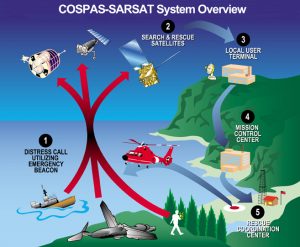Coast Guard Urges Safe Use and Registration of Emergency Beacons
Every April 6th marks “406 Day,” a nationwide effort led by the National Oceanic and Atmospheric Administration (NOAA) to educate mariners about Emergency Position Indicating Radio Beacons (EPIRBs). EPIRBs are critical life-saving devices that send out distress signals to rescue teams when someone is in danger on the water.
marks “406 Day,” a nationwide effort led by the National Oceanic and Atmospheric Administration (NOAA) to educate mariners about Emergency Position Indicating Radio Beacons (EPIRBs). EPIRBs are critical life-saving devices that send out distress signals to rescue teams when someone is in danger on the water.
EPIRBs work by transmitting a recognized distress signal via satellite, quickly alerting search and rescue (SAR) teams to the location of an emergency. However, for these devices to effectively save lives, it’s crucial that they are correctly registered, regularly tested, responsibly used, and properly disposed of when no longer in use.
The Fifth Coast Guard District highlighted the need for responsible EPIRB management by sharing these 2024 statistics: they responded to 830 EPIRB alerts. Of these, only 18 were genuine distress signals. 386 alerts were confirmed as false, and another 426 were unknown or suspected false alerts. These unnecessary alerts resulted in over 40 hours spent on surface searches, more than 45 hours on air searches, and over 2,550 command center man-hours.
Matthew Brooks, the search and rescue program manager for the Fifth Coast Guard District, stressed the importance of reducing false alerts. “False alerts can delay or distract from responses to real emergencies,” Brooks explained. “Proper registration and responsible handling of EPIRBs help us save lives and protect our crews.”
Federal law mandates that all EPIRBs be registered with NOAA’s SARSAT Beacon Registration Database. Registration is free and can be completed online at www.beaconregistration.noaa.gov or by calling 1-888-212-SAVE (7283). Owners should keep their registration updated, especially when transferring the beacon to a new owner or when it is disposed of.
NOAA points out that 98% of activations for EPIRBs, emergency locator transmitters, and personal locator beacons turn out to be false alarms. To prevent accidental activations and ensure proper disposal, NOAA advises owners to remove the EPIRB’s battery, clearly label the beacon as deactivated, and update the registration accordingly.
This 406 Day, remember that your EPIRB is more than just equipment, it’s a vital lifeline. Proper care, registration, and responsible use ensure that these beacons can effectively aid in saving lives at sea.
 Maritime Injury Law Blog
Maritime Injury Law Blog

